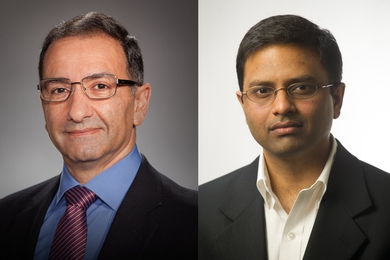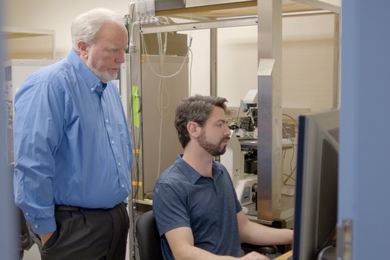MIT OpenCourseWare (OCW), one of the landmark projects that helped spark the open education movement, marks the 10-year anniversary of the site's launch today. On Oct. 1, 2003, the OCW site officially launched, sharing the core educational materials — including syllabi, lecture notes, assignments and exams — from 500 MIT courses freely and openly on the Web under a license that permits flexible reuse. Since launch, the site has grown to include materials from more than 2,180 courses across all of MIT's undergraduate and graduate programs.
The site continues to be once of the most widely used educational resources on the Web, attracting more than 23 million visits in 2012 and an expected 27 million by the end of 2013. An estimated 170 million individuals worldwide have accessed OCW material since Oct. 1, 2003. Over the past ten years, the program has generated some dramatic usage numbers, including:
A voluntary effort for the MIT faculty, OCW is one of the largest intellectual philanthropy efforts ever by a higher education institution. About 70% of MITs current faculty share course materials through the site, with 1,750 total professors, researchers, lectures and teaching assistants contributing to the site over its history.
The OCW site includes materials from 5 Nobel Prize winners and 44 MacVicar Fellows, professors who are recognized by the Institute for their outstanding contributions to MIT undergraduate education. Several MIT faculty members have become very well known for their contributions to the site, including physics professor Walter Lewin, whose materials have received more than 9 million visits and mathematics professor Glbert Strang, whose materials have received over 7.2 million visits.
MIT OpenCourseWare supported the creation of the OpenCourseWare Consortium, a global membership organization of schools and organizations sharing educational materials openly. Incorporated as an independent non-profit organization in 2008, the Consortium includes as members more than 280 universities and organizations from 50 countries and territories worldwide that collectively share more than materials from over 20,000 courses.
MIT OpenCourseWare was also one of a handful of programs that launched the open educational resources movement, which shares text books, journal articles, courseware, software, and other educational tools from hundreds of organizations under open licenses that permit reuse, modification and redistribution. Support for open educational resources has been a focus of UNESCO policy since 2002 and has been embraced by governments around the world, including those of the Netherlands, Korea, Vietnam and the United States.
MIT OpenCourseWare has introduced numerous innovations in the past 10 years, including:
The site continues to be once of the most widely used educational resources on the Web, attracting more than 23 million visits in 2012 and an expected 27 million by the end of 2013. An estimated 170 million individuals worldwide have accessed OCW material since Oct. 1, 2003. Over the past ten years, the program has generated some dramatic usage numbers, including:
- 10 billion server hits (files requested from OCW servers)
- 870 million page views
- 135 million visits to the main OCW site
- 45 million visits to translations of OCW content
- 43.5 million iTunes lecture video downloads
- 48.6 million YouTube lecture video views, and
- 18.5 million downloads of course content .zip files.
A voluntary effort for the MIT faculty, OCW is one of the largest intellectual philanthropy efforts ever by a higher education institution. About 70% of MITs current faculty share course materials through the site, with 1,750 total professors, researchers, lectures and teaching assistants contributing to the site over its history.
The OCW site includes materials from 5 Nobel Prize winners and 44 MacVicar Fellows, professors who are recognized by the Institute for their outstanding contributions to MIT undergraduate education. Several MIT faculty members have become very well known for their contributions to the site, including physics professor Walter Lewin, whose materials have received more than 9 million visits and mathematics professor Glbert Strang, whose materials have received over 7.2 million visits.
MIT OpenCourseWare supported the creation of the OpenCourseWare Consortium, a global membership organization of schools and organizations sharing educational materials openly. Incorporated as an independent non-profit organization in 2008, the Consortium includes as members more than 280 universities and organizations from 50 countries and territories worldwide that collectively share more than materials from over 20,000 courses.
MIT OpenCourseWare was also one of a handful of programs that launched the open educational resources movement, which shares text books, journal articles, courseware, software, and other educational tools from hundreds of organizations under open licenses that permit reuse, modification and redistribution. Support for open educational resources has been a focus of UNESCO policy since 2002 and has been embraced by governments around the world, including those of the Netherlands, Korea, Vietnam and the United States.
MIT OpenCourseWare has introduced numerous innovations in the past 10 years, including:
- the Highlights for High School site, which indexes OCW materials appropriate for advanced high school study in the areas of Calculus
- OCW Scholar courses, which present robust sets of course materials in logical units to facilitate independent study, and
- the Mechanical MOOC, a collaboration with Peer 2 Peer University, OpenStudy and Codecademy to create a MOOC-like learning experience out of existing open materials and services.






